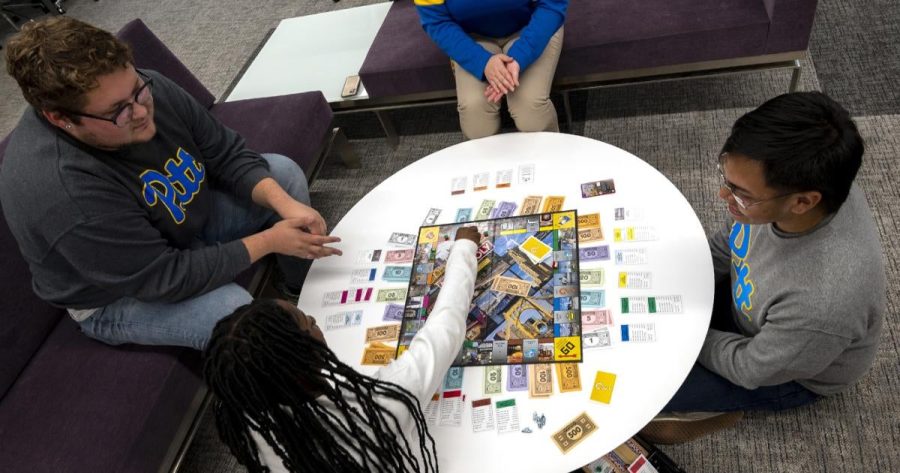Pittsburgh gets its own edition of Monopoly
Pitt students play Monopoly.
December 5, 2022
Pittsburgh has “passed Go” as the newest city to receive an official Monopoly game.
Top Trumps USA Inc. in partnership with Hasbro, the makers of Monopoly, started creating U.S. city-specific editions of Monopoly in 2018. Pittsburgh is the ninth city featured. While there are similar games, such as “Pittsburgh in a Box” and “Pittsburgh-opoly,” this is the first official Pittsburgh version of Monopoly made by the makers of the game.
Top Trumps asked Pittsburghers to send suggestions of landmarks and places they would like to see featured on the game’s board in February 2022. Some of the iconic Pittsburgh landmarks featured in the final game include the Cathedral of Learning, the Duquesne Incline and Point State Park.
Allegheny County Executive Rich Fitzgerald, Pittsburgh Mayor Ed Gainey and local TV personality Rick Sebak joined Mr. Monopoly, the board game’s mascot, at Grandview Overlook on Mount Washington for the initial call for submissions.
A group of four Pitt Pathfinders, including Sean Ramos-Izquierdo and Rosie Dailey, recently played the Pittsburgh-themed Monopoly game.
Ramos-Izquierdo, a senior psychology major, said he has always loved Monopoly since it was a game he and his family could play together.
“Playing the game with my fellow Pathfinders just brought back so many happy memories of my childhood and spending time with my family which I don’t get to see as often as I would like,” Ramos-Izquierdo said. “Also, as a Pathfinder, it was really interesting to use a lot of my knowledge on the game board which is truly reflective of what the city looks like as a whole.”
Zachary Horton, an associate professor of English and media studies, said he didn’t know about the game until the beginning of November. However, Horton said he was not surprised that Pittsburgh now has its own version of Monopoly.
According to Horton, the regionalization of Monopoly dates to the early 20th century, when people would adapt early versions of Monopoly to their own local city or area.
“It actually makes sense that Monopoly would be localized, given that it’s about property,” Horton said. “There’s a logic there. The logic of local property and the value that can be extracted from it.”
Horton said certain board games are developed for players to generate a narrative through their dynamic and play of the game. Games that intentionally generate narratives include “Gloomhaven,” a high fantasy campaign game, and “Tales of the Arabian Nights,” where players generate stories as they adventure in the world of the Arabian nights.
While the makers of Monopoly did not initially develop the game with the intention of creating a story, Horton said players do still create a “thin narrative” when playing the game.
“There’s a story about the rise and fall of the various characters that the players are playing,” Horton said. “There’s a story about their rise and fall in the capitalist system and the property they own and the ruin they come to.”
According to Horton, a game called The Landlord’s Game inspired the early versions of Monopoly. The game featured cards that explained how capitalism worked, including quotes about the extraction of capital from rents, and generally highlighted the system’s inequalities.
Charles Darrow, the creator of Monopoly, removed the anti-capitalist details in his game. Despite removing anti-capitalist details from the game, Horton said certain economic issues that people face right now are similar to the narrative in Monopoly.
“Right now, amidst inflation, the status of rent and the difficulty of owning property, or buying a house, is at something of a low point,” Horton said. “So, Monopoly — the game that sort of exposes the unfairness and the inequities of rent-based capitalism — is actually really relevant right now.”
Even though Ramos-Izquierdo and Dailey enjoyed the game, they both said they wished that the game pieces were more Pittsburgh-related.
“My only thing I maybe would have changed is have the pieces be more related to the city, like a panther, ketchup bottle or even a bridge, since Pittsburgh has more bridges than Venice,” Ramos-Izquierdo said. “But that’s just me being picky.”
Dailey, a senior communications major, said the Pathfinder group had fun trying to relate the pieces to Pittsburgh.
“Although it has the original game pieces, we had fun making up names for them, the cat was a panther, the ship was a Gateway Clipper, the thimble was a can of tomato soup,” Dailey said. “A bit of a stretch, but we had fun.”
Dailey said she was excited to see the landmarks and references the game included since she grew up in Allegheny County.
“Of course, the Cathedral of Learning was a stand-out, but Eat’N Park was also a pleasant surprise to see,” Dailey said. “There are so many details that allude to the city, [it’s] very silly.”








